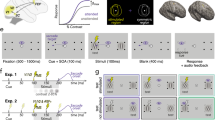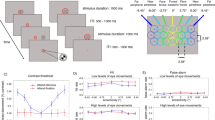Summary
The present experiments were designed to study the control of visual thresholds in relation to selective attention and goal directed saccadic eye movements in human subjects. The results demonstrate that visual thresholds increase by about 0.5–1 log unit when targets are repeatedly presented in the periphery of the visual field while the subjects are fixating. The diameter of the adapted area and the amplitude of the threshold elevation increase with retinal eccentricity but do not depend on other stimulus parameters such as target size or target luminosity. Irrespective of target size the diameter of the adapted field is in the range of 5 ° close to the fovea and reaches up to 20 ° in the visual field periphery. This elevation of detection thresholds can be reset either by adapting a mirror symmetric area in the contralateral visual field or by directing a saccadic eye movement towards a target which is presented in an area mirror symmetric to the adapted field. When saccades are performed in the absence of the target stimulus or when they are directed towards targets outside the mirror symmetric area no resetting occurs. Adaptation is further prevented when the subject is allowed to saccade towards the adapting target. Measurements in patients with cortical hemianopia indicate, that these phenomena are mediated by subcortical visual centers since they can be influenced by stimulation in the blind hemifield. Participation of subcortical centers, especially of the tectum, is further suggested by the numerous correlations between the present psychophysical observations and the available neurophysiological data on subcortical visual pathways. It is concluded that it is one of the functions of the retino-tectal system to determine detection thresholds in a retinotopically organized way and to guide visual attention towards particular areas within the visual field. The observations in hemianopic patients suggest that these operations are accomplished in parallel to cortical analysis and remain functional after striatal lesions. They are, however, inaccessible to conscious experience.
Similar content being viewed by others
References
Benevento, L.A., Fallon, J.H.: The ascending projection of the superior colliculus in the rhesus monkey (Macaca Mulatta). J. comp. Neurol. 160, (3), 339–362 (1975)
Blakemore, C., Sutton, P.: Size Adaptation: A new aftereffect. Science 166, 245–247 (1969)
Brandt, Th., Dichgans, J., Koenig, E.: Differential effects of central versus peripheral vision on egocentric and exocentric motion perception. Exp. Brain Res. 16, 476–491 (1973)
Campbell, F.W., Maffei, L.: Electrophysiological evidence for the existence of orientation and size detectors in the human visual system. J. Physiol. (Lond.) 207, 625–652 (1970)
Cowey, A.: Atrophy of retinal ganglion cells after removal of striate cortex in a rhesus monkey. Perception 3, 257–260 (1974)
Cynader, M., Berman, N.: Receptive-field organization of monkey superior colliculus. J. Neurophysiol. 35, 187–201 (1972)
Frost, D., Pöppel, E.: Different programming modes of human saccadic eye movements as a function of stimulus eccentricity: Indications of a functional subdivision of the visual field. Biological Cybernetics 23, 39–48 (1976)
Gilbert, C.D., Kelly, J.P.: The projections of cells in different layers of the cat's visual cortex. J. comp. Neurol. 163, 81–105 (1975)
Gilinsky, A.S., Doherty, R.S.: Interocular transfer of orientational effects. Science 164, 454–455 (1969)
Goldberg, M.E., Wurtz, R.H.: Activity of superior colliculus in behaving monkey. I. Visual Receptive Fields of Single Neurons. J. Neurophysiol. 35, 542–559 (1972)
Goldberg, M.E., Wurtz, R.H.: Activity of superior colliculus in behaving monkey. II. Effect of attention on neuronal responses. J. Neurophysiol. 35, 560–574 (1972)
Goodale, M.A.: Corticotectal and intertectal modulation of visual responses in the rat's superior colliculus. Exp. Brain Res. 17, 75–86 (1973)
Goodale, M.A., Murison, R.C.C.: The effects of lesions of the superior colliculus on locomotor orientation and the orienting reflex in the rat. Brain Res. 88, 243–261 (1975)
Graybiel, A.M.: Some extrageniculate visual pathways in the cat. Invest. Ophthal. 11, 322–332 (1972)
Graybiel, A.M.: The thalamo-cortical projection of the so-called posterior nuclear group: A study with anterograde degeneration methods in the cat. Brain Res. 49, 229–244 (1973)
Hubel, D.H., LeVay, S., Wiesel, T.N.: Mode of termination of retinotectal fibers in macaque monkey: an autoradiographic study. Brain Res. 96, 25–90 (1975)
Maffei, L., Fiorentini, A., Bisti, S.: Neural correlate of perceptual adaptation of gratings. Science 182, 1036–1038 (1973)
Mohler, C.W., Wurtz, R.H.: Organization of monkey superior colliculus: Intermediate layer cells discharging before eye movements. J. Neurophysiol. 39, 722–744 (1976)
Perenin, M.T., Jeannerod, M.: Residual vision in cortically blind hemifields. Neuropsychologia 13, 1–7 (1975)
Pöppel, E., Harvey, L.H., Jr.: Light-difference threshold and subjective brightness in the periphery of the visual field. Psychol. Forsch. 36, 145–161 (1973)
Pöppel, E., Richards, W.: Light sensitivity in cortical scotomata contralateral to small islands of blindness. Exp. Brain Res. 21, 125–130 (1974)
Pöppel, E., Held, R., Frost, D.: Residual visual functions after brain wounds involving the central visual pathways in man. Nature (Lond.) 243, 295–296 (1973)
Pöppel, E., von Cramon, D., Backmund, H.: Eccentricity specific dissociation of visual functions in patients with lesions of the central visual pathways. Nature (Lond.) 256, 489–500 (1975)
Rezak, M., Benevento, L.A.: Some cortical projections of the inferior pulvinar in the rhesus monkey (macaca mulatta). Anat. Rec. 181, 461 (1975)
Ritter, M., Lücke, G., Zihl, J.: Selektive Analyse von Bewegungsrichtung und Geschwindigkeit in der visuellen Wahrnehmung des Menschen. Psychol. Forsch. 36, 267–296 (1973)
Robert, F., Cuenod, M.: Electrophysiology of the intertectal commissures in the pigeon. II. Inhibitory interaction. Exp. Brain Res. 9, 123–136 (1969)
Saraiva, P.E.S., Aragao, A.S., Magalhaes-Castro, B.: Recovery of depressed superior colliculus activity in neodecorticate opossum through the destruction of the contralateral superior colliculus. Brain Res. 112, 168–175 (1976)
Schiller, P.H., Koerner, F.: Discharge characteristics of single units in superior colliculus of the alert rhesus monkey. J. Neurophysiol. 34, 920–936 (1971)
Schneider, G.E.: Two visual systems. Science 163, 895–902 (1969)
Singer, W., Bedworth, N.: Correlation between the effects of brain stem stimulation and saccadic eye movements on transmission in the cat lateral geniculate nucleus. Brain Res. 72, 185–202 (1974)
Singer, W., Tretter, F., Cynader, M.: The effect of reticular stimulation on spontaneous and evoked activity in the cat visual cortex. Brain Res. 102, 71–90 (1976)
Sloan, L.L.: The Tübinger Perimeter of Harms and Aulhorn. Arch. Ophthal. 86, 612–622 (1971)
Sprague, J.M.: Interaction of cortex and superior colliculus in mediation of visually guided behavior. Science 153, 1544–1547 (1966)
Trojanowski, J.Q., Jacobson, St.: Pulvinar projections to frontal eye fields. Brain Res. 80, 392–4111 (1974)
Weiskrantz, L., Warrington, E.K., Sanders, M.D., Marshall, J.: Visual capacity in the hemianopic field following a restricted occipital ablation. Brain 97, 709–728 (1974)
Wurtz, R.H.: Visual receptive fields of striate cortex neurons in awake monkeys. J. Neurophysiol. 32, 727–742 (1969)
Wurtz, R.H., Goldberg, M.E.: Activity of superior colliculus in behaving monkey. III. Cells discharging before eye movements. J. Neurophysiol. 35, 575–586 (1972)
Wurtz, R.H., Mohler, C.W.: Selection of visual targets for the initiation of saccadic eye movements. Brain Res. 71, 209–214 (1974)
Wurtz, R.H., Mohler, C.W.: Organization of monkey superior colliculus: Enhanced visual response of superficial layer cells. J. Neurophysiol. 39, 745–765 (1976)
Wurtz, R.H., Mohler, C.W.: Enhancement of visual responses in monkey striate cortex and frontal eye fields. J. Neurophysiol. 39, 766–772 (1976)
Author information
Authors and Affiliations
Rights and permissions
About this article
Cite this article
Singer, W., Zihl, J. & Pöppel, E. Subcortical control of visual thresholds in humans: Evidence for modality specific and retinotopically organized mechanisms of selective attention. Exp Brain Res 29, 173–190 (1977). https://doi.org/10.1007/BF00237040
Received:
Issue Date:
DOI: https://doi.org/10.1007/BF00237040




